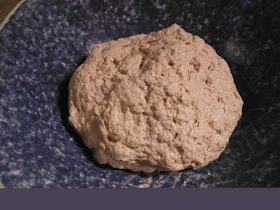Pumpkin Pulp Bread
I've been reading the Harry Potter series again, for the first time (last time I tried, I was so bored, I gave up, thinking they were merely kid's books; now I figured I'd at least skim read it, to see how it was put together). And when I read about how all the student wizards and witches at Hogwarts drink pumpkin juice, I recalled seeing a blog somewhere in German where someone used their Dampfentsafter (steam juicer) to extract juice from a pumpkin (e.g. here, they used it to make a cordial(?) with vodka! Sorry Harry, you're not old enough yet for this kind of pumpkin juice).
Now that pumpkins are in the stores, I thought I'd give it a try.
From one ordinary jack-o-lantern type pumpkin, I bottled 4 jars of pumpkin juice (and it is really nothing special, it is clear in colour and it just tastes like mild squash; it can eventually be fermented, if I want to try it, but it will require quite a bit of sugar or honey to make a decent pumpkin wine or mead). I reserved the pumpkin pulp, which was still quite wet, since it had been steamed in the Dampfentsafter. Today I used 800g of that pulp, straight from the refrigerator, to make a sourdough whole wheat bread.
Ingredients:
- 1000g ww flour
- 50g wheat germ
- 800g pumpkin pulp
- 200g sourdough starter
- 20g coarse salt
The salt was added with 50g of the pumpkin pulp. I kneaded the dough prior to adding the salt, to ensure that the pulp mixed all the flour well. After adding the salt, I squooshied it in, and then kneaded it again. Curiously, the texture of the dough utterly changed when the salt was added, and not necessarily for the better. The salt probably pulled any remaining water from the cells of the pumpkin pulp, and the dough became slimy with wet. I kneaded it for about 5 minutes, until I could no longer feel the coarse salt in the dough, and the consistency became better.
Once it was easier to work with, I finished off kneading it. It went back into the bowl and for the next couple of hours I stretched and folded it the best I could. It really wasn't all that well hydrated, despite the slime. It is impossible to say, of course, just how hydrated the dough was, because I had only added pulp, and hadn't added any water directly. If I had to guess, though, based purely on how the dough felt in my hands, it was probably somewhere around 65% hydrated -- pretty low, compared to most of the dough I've been working with.
The dough was refrigerated overnight once it was divided and placed in the baskets. In the morning I set it out and walked the dog for a couple of hours. I preheated the stone in the oven and baked it with steam. The dough plumped up in the oven drastically.
Results
This doesn't taste too pumpkiny. It is a mild tasting bread. You can put anything on it -- jam, cheese, whatever. The sourdough seemed to like the dough, it fermented well despite the removal of the slightly sweet juice; but this dough wasn't well hydrated. It could probably have done with some water -- or perhaps, the juice I had extracted from it in the first place.
Notes to Myself
- While there is still a lot of food value in the pumpkin pulp, all of the natural yeasts and enzymes would have been killed or denatured in the steaming process. What is left is the pumpkin minerals and carbs. Not sure whether this method is better than baking the pumpkin to make the pulp, like I've done in the past -- but it sure is easier.
Mostly I wondered whether removing the juice would concentrate the taste in the remaining pulp, or if it would flatten the taste. I suspect the taste is somewhat flattened, but not too much. The steam juicer certainly did not take all of the wetness from the pulp, it has still quite a lot of water in it.






























































